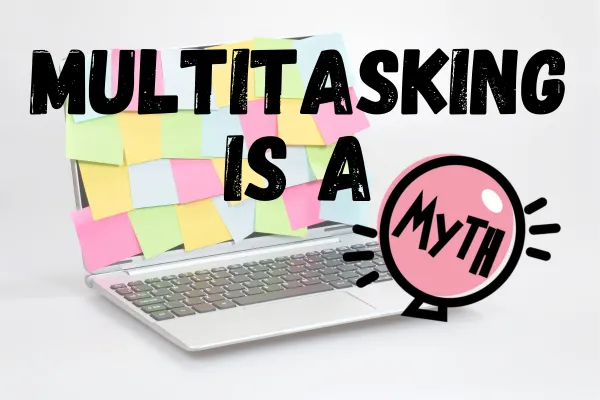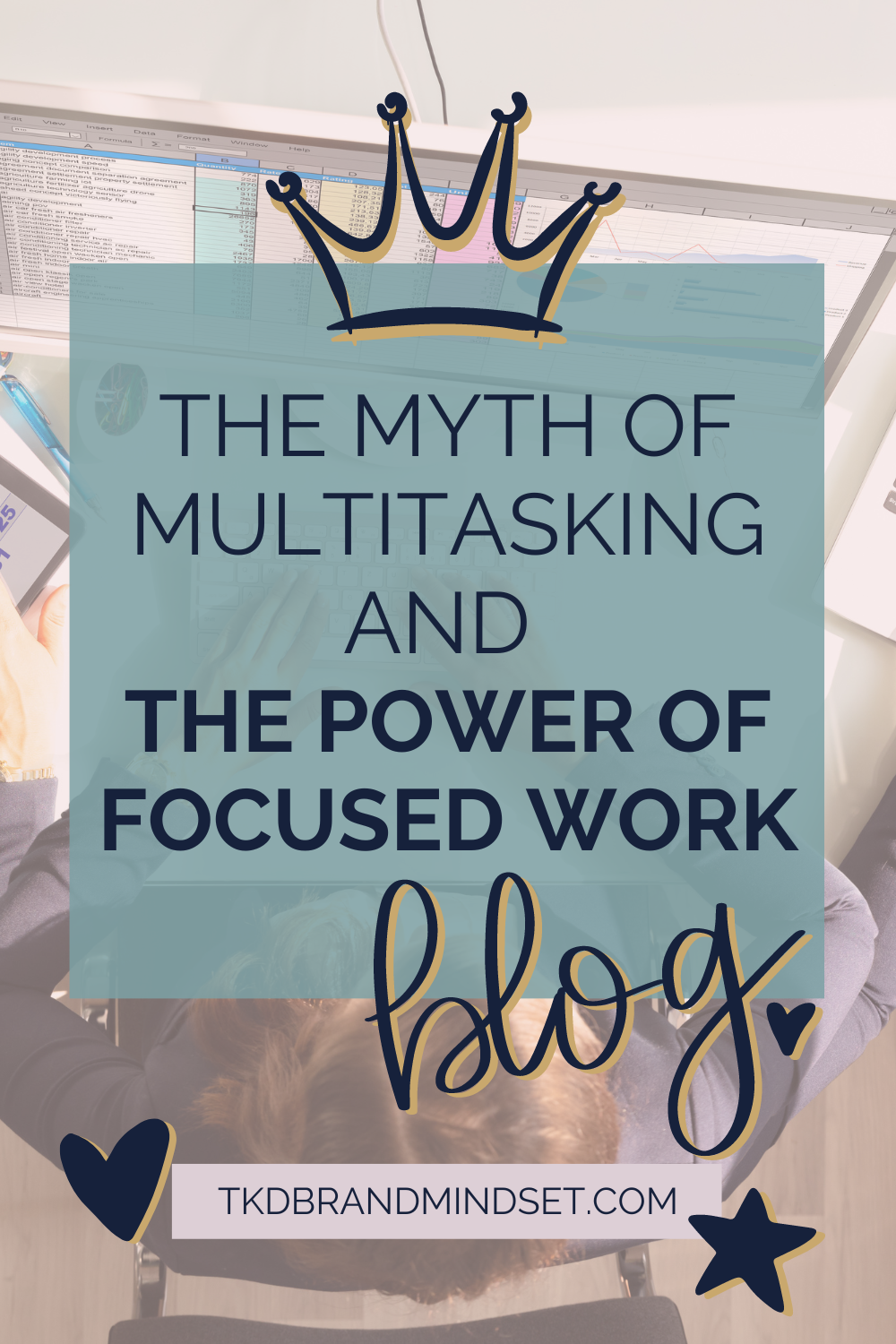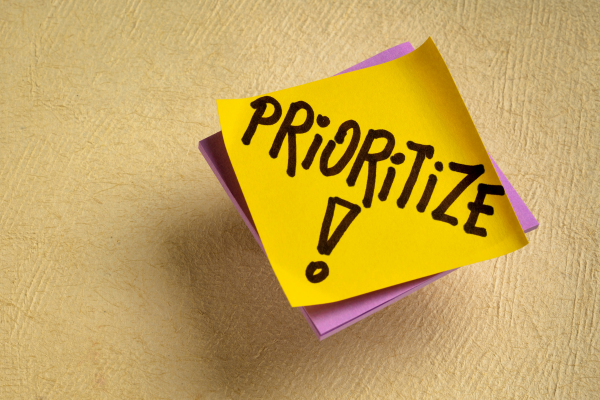My BLOG
Get To Work, Girl

The Myth of Multitasking and the Power of Focused Work
“Multitasking is a lie.” - Gary Keller, author of "The One Thing".
This blog contains affiliate links, and I receive a small compensation at no extra cost to you. All proceeds from affiliate purchases are donated to Petri's Place Wildlife Rehabilitation.
The Myth of Multitasking and the Power of Focused Work
My fellow women side hustlers, today we end the notion that multitasking is a superpower.
Together we’ll bust this myth and in its place activate our true abilities. As we go along this journey today, we’ll come to accept that - multitasking is in fact…a LIE!

The Myth of Multitasking
In today's fast-paced world, multitasking is often heralded as a desirable skill, especially for ambitious women like us who’re juggling a side hustle along with other life responsibilities. We even try to convince ourselves it’s some sort of super power.
However, today I’ll unveil the reality behind this perceived ability and understand why multitasking is more of a myth than an extraordinary ability.
Defining Multitasking
Traditionally, multitasking refers to the ability to handle more than one task simultaneously.
An example of TRUE multitasking would be driving your car while having a conversation with a passenger and enjoying the fries out of a fast food order. You are literally doing all of the “things” at one time.
However, when we describe multitasking we tend to try to paint an image of someone efficiently juggling numerous tasks at once, seamlessly shifting from one to another without missing a beat.
Lies.
This magical ability is often glorified as a trait of highly productive and successful individuals. We multitaskers tend to try and wear it as a badge of honor while in reality not being as productive as we’d like to admit.
When you look at the definition and example, you logically can see this is literally impossible to master with tasks.
Unless you are talking about walking and talking at the same time, when we describe multitasking we are basically stretching the truth.

Introducing Switch-tasking
So if we’re not multitasking, what are we doing then?
Contrary to popular belief, what we often think of as multitasking is, in reality, 'switch-tasking.'
This involves rapidly shifting attention from one task to another, rather than performing them simultaneously.
Each "switch" might feel instantaneous, but it's not a seamless process. Not only that, it's super disruptive to our flow state and focus.
Switch-tasking is the continuous toggling between tasks, which, unlike true multitasking, involves a stop-and-start process.
When we switch tasks, our brain has to reorient to the new task, losing the rhythm and focus of the previous one.
Picture it; you’re sitting at your desk writing captions for your social media content and you get a call from a client that wants to move their appointment. You have to stop what you are doing on one task and focus on the call, calendar and whatever goes along with moving the appointment. You may even need to reschedule something ELSE in order to accommodate the client.
You didn’t actually continue working on the captions while changing the appointment time.
This is not just a shift in attention but a complete cognitive redirection. Your brain has now jumped to a new subject matter and is looking for a new flow.
How the Brain Processes Tasks
The human brain, despite its incredible capabilities, is not wired to perform multiple tasks that require high levels of cognitive function at the same time.
When we attempt to multitask, what our brain is actually doing is rapidly switching its focus from one task to another. This process, often termed as the "switch cost," can accumulate significantly over time.
Research by the American Psychological Association highlights that task switching can lead to as much as a 40% decrease in productivity.
FORTY PERCENT ladies.
This decrease is attributed to the time lost in transitioning between tasks and the mental blocks that occur during the switch.
Earl Nightingale once said, “Concentrate all your thoughts upon the work in hand. The sun's rays do not burn until brought to a focus.”

The Harsh Reality of Switch-tasking
In the quest to debunk the myth of multitasking, it's essential to go deeper into the reality of switch-tasking.
As previously defined, it involves rapidly shifting focus from one task to another, rather than doing them simultaneously.
Let’s look further at what it looks like to our brain but also some of the other effects of this less than super power.
Decreased Efficiency and Productivity
One of the most significant effects of switch-tasking is the reduction in efficiency and productivity. When we switch tasks, there's an inevitable "start-up" time required for our brains to orient to the new task, even if this switch happens in a matter of seconds.
Increased Cognitive Load and Mental Fatigue
Switch-tasking puts a heavy load on our cognitive resources. Juggling multiple tasks demands more from our working memory and attentional systems, leading to mental fatigue.
The prefrontal cortex, responsible for executive functions such as decision-making and problem-solving, is heavily taxed during switch-tasking.
This overburden can lead to a decrease in cognitive function over time and makes sustaining attention on a single task more challenging.
Impact on Quality of Work
The quality of work often suffers under switch-tasking. With divided attention, the depth and thoroughness with which a task is completed are compromised. This can lead to more errors and a decrease in the overall quality of the output.
A study from Stanford University found that heavy multitaskers are more prone to errors and demonstrate poorer memory and cognitive control compared to those who focus on single tasks.
Stress and Burnout
Continuously switching between tasks without adequate breaks can lead to increased stress levels and eventually burnout. The constant demand to perform multiple tasks simultaneously can create a sense of perpetual urgency and pressure, leading to stress-related symptoms.
Chronic switch-tasking, without proper management, can contribute to long-term stress, affecting both mental and physical health. It can lead to symptoms like anxiety, irritability, and even depression.
So we’re essentially making ourselves more mentally exhausted leading to being frustrated which causes mistakes and then we can’t even remember what we were doing to begin with but we know we’re mad about it.
Sound at all familiar?
Implications for Side Hustlers and Entrepreneurs
For women with side hustles or those venturing into entrepreneurship, understanding the impact of switch-tasking is crucial. While the demands of managing multiple aspects of a business might tempt one into constant task-switching, it's vital to recognize the long-term inefficiencies and potential health implications this practice can have.
My Practical Advice to You: Emphasizing the importance of focused, uninterrupted work periods can significantly enhance productivity and reduce stress. Adopting strategies such as time-blocking (my favorite thing) and prioritization can help in minimizing the need to switch tasks frequently. My Anti-Distraction Planner lays all of this out for you and the printable version is FREE!
Ladies, realizing the limitations and inefficiencies of this so-called superpower “multitasking” is the first step in a path towards more efficient, productive, and healthier work habits.
The Flow State and Task Switching
In the idea of productivity and peak performance, understanding the concept of the 'flow state' is pivotal. I want to define flow state and explain how task switching can significantly disrupt this highly productive and fulfilling state.
Understanding the Flow State
The flow state, also known as being 'in the zone,' is a state in which you are fully immersed in an activity or task with a feeling of energized focus, full involvement, and enjoyment. This is the get “stuff” done mode. Flow State was popularized by psychologist Mihaly Csikszentmihalyi, representing getting completely absorbed in what you’re doing, but productively.
Characteristics of Flow: You have a sense of control over the task or activity, a loss of self-consciousness, and almost no sense of time. In “the zone” aka flow, you are so absorbed in the task that everything else fades away.
The Neurological Aspect: Neurologically, the flow state is marked by a specific pattern of brain activity. During flow, the brain releases a cocktail of feel-good neurotransmitters like dopamine, serotonin, and endorphins, enhancing both pleasure and focus. This is why you feel you are on a high when being super productive.
The Impact of Task Switching on Flow State
While the flow state is highly beneficial for productivity and personal satisfaction, achieving and maintaining it is delicate. Task switching severely disrupts the flow state, quickly ending your high.
Disruption of Focus: Entering the flow state requires a level of concentration and uninterrupted focus that just doesn’t work with task switching. When we switch tasks, we essentially 'break' the flow, pulling ourselves out of this deep focus. Buzz kill.
Time to Re-enter Flow: Once interrupted, re-entering the flow state isn't immediate. Research by Gloria Mark, an expert in the field of digital distraction, indicates that it takes an average of 23 minutes and 15 seconds to return to the original task after an interruption. This can be even longer for re-entering a flow state, given the depth of concentration required. 23 minutes multiplied by every distraction. Geezus.
Cognitive Costs: Each interruption not only delays the return to the task but also depletes cognitive resources, making it harder to achieve the deep focus necessary for the flow state. The brain needs time to reorient itself to the nuances of the task, recalling where one left off and re-establishing the mental pathways that were active before the interruption. This is why you feel mentally exhausted. Your brain has been playing leap frog all day.
Implications for Productive Work
For anyone, especially women like us managing side hustles or entrepreneurial ventures, the implications are clear: to maximize productivity and enjoyment in work, minimizing task switching is crucial. Preserving blocks of uninterrupted time is not just a scheduling preference, but a necessity for tapping into the profound benefits of the flow state.
Scheduling tasks in a way that allows for extended periods of undisturbed focus can significantly enhance the quality and efficiency of work. This approach not only boosts productivity but also contributes to a more satisfying work experience, as the flow state is often associated with peak personal performance.
Ladies, by consciously creating environments and schedules that reduce the likelihood of interruptions, we can more readily access this powerful flow state, leading to a more productive, creative, and enjoyable work life.
Strategies to Avoid Multitasking Overwhelm
So now we all understand that the anti-super power multitasking aka switching can lead to feelings of being overwhelmed, crap productivity and a loss of well-being. Now we need to combat this by implementing strategic approaches to work that can be incredibly beneficial. Here are my favorite and proven ways to tackle this problem.

Prioritizing Tasks:
For the most effective time management and productivity you must, must, must learn to prioritize tasks properly. By identifying the most crucial tasks and focusing on them first, you can ensure that your efforts are concentrated on what truly matters.
Without the use of tools or processes, everything that is put in front of us will be a “fire” that needs to be put out. Every request, email, text alert and phone call is the next big priority.
It is literally not possible for every task you need to complete to be considered important or a top priority.
Not even close to possible.
One of my most FAVORITE processes is the Eisenhower Matrix. I’ve found so much success with this process that it’s incorporated into my Anti-Distraction Planner and a part of my weekly prioritization process.
The Eisenhower Matrix: This process divides tasks into four categories based on their urgency and importance. This helps in distinguishing between tasks that require immediate attention and those that can be scheduled for later or delegated. The four quadrants can be written on a sheet of paper, dry erase board or even done digitally. I first do a brain dump where every idea, thought, new task, parking lot item or request is written down all at once. Then I divide them into the four sections of the matrix. The final steps are grooming that list and truly coming to a priority that is appropriate for the task then filling out my planner.
Daily Top Three: Another practical approach is to choose the top three tasks that need to be accomplished each day. This focus prevents the overwhelm of a lengthy to-do list and ensures that the most critical tasks are not lost in the shuffle of less important ones. I personally use this daily as a part of my process that follows the matrix work. The tasks that are to be completed each day are also prioritized with the top 3 items followed by other less critical tasks that can be moved to a parking lot or rescheduled if not completed. This keeps the focus on the most important tasks without the overwhelm of finishing everything when it’s not possible.

Time Blocking
Never, ever, ever do I schedule my day without time blocks. (and the use of a timer)
Time blocking is a highly effective method for dedicating focused time to tasks without the interruptions of switch-tasking. This involves setting aside specific blocks of time for individual tasks or types of work and sticking to these time allocations strictly.
One key tip, don’t use your phone as your timer. This is a rabbit hole risk just waiting to happen. When your phone alert goes off you now have the device in your hands and all hell can break loose. Before you know it, you’re looking at texts and emails you missed. Two seconds later you’re doom scrolling.
No ma’am.
Use a task timer (my favorite timer ever linked here...), Alexa device that you speak to or a good old fashioned tomato shaped kitchen timer.
Whatever you use, just time it and adhere to the time blocked off for the particular task or break.
Dedicated Focus: By time blocking, you dedicate your full attention to one task at a time, which can significantly enhance the quality of work and efficiency. It also helps in entering the flow state, where your productivity can reach its peak.
Scheduling Breaks: Including scheduled breaks within your time blocks is crucial. Breaks prevent burnout and keep your mind fresh, which is essential for maintaining a high level of productivity throughout the day.
Minimize Distractions
Create a workspace that is organized and free from clutter. A well-organized workspace can significantly reduce stress and improve focus.
Ditch the phone or turn it to silent. Close all social media or other mind traps on your desktop.
Incorporate mindfulness practices such as meditation or deep breathing exercises can also help in maintaining focus and reducing the urge to give in to distractions. Personally I like to use guided visualization for about 7 to 15 minutes in the morning to get started.
Creating a workable environment can significantly reduce the overwhelm associated with multitasking and lead to more productive, satisfying, and successful work days.
This advice is particularly beneficial for women managing side hustles or businesses, where effective time management is key to getting s@#t done.
“Do less, then obsess.” – Morten T. Hansen, author of "Great at Work".
Benefits of Focused Work for Side Hustlers and Entrepreneurs
For side hustlers and entrepreneurs, the benefits of focused work cannot be overstated.
In an environment where time is often limited and the list of tasks seems endless, the ability to focus intensely on one task at a time can be a game changer.
How?
Increased Efficiency and Productivity: Focused work allows us to work deeper on a task, leading to faster and more efficient results. Obviously this is crucial for side hustlers who often have to balance their business with other full-time work/mom/wife/taxi driver commitments. By focusing on one task at a time, we can maximize our very limited work hours, getting more done in less time.
Enhanced Quality of Work: When attention is not all jacked up by constant task-switching, the quality of work inevitably improves. For entrepreneurs, the quality of work is often synonymous with our brand’s reputation. Focused work also ensures that each task is given the attention it deserves, resulting in our best work.
Greater Satisfaction and Fulfillment: Being able to focus on our work can lead to a greater sense of accomplishment. This sense of a “job well done” is important for maintaining our motivation, especially in the challenging early stages of a side hustle or business venture where we’re constantly beating ourselves up.

So We All Agree To Tackle Challenges One At A Time Now?
It’s not just a strategy; it's a mindset that can lead to greater success and less stress. For us, this approach is especially beneficial.
Bottom line, for those of us women managing a side hustle or running a business, adopting a focused approach to work and tackling challenges one at a time can lead to significant benefits.
This will not only enhance productivity and the quality of outcomes but also give us a healthier work-life balance and greater overall satisfaction in your entrepreneurial journey.
“The secret of your future is hidden in your daily routine.” – Mike Murdock.
As I wrap this up I just want to reiterate that while multitasking may seem like a necessary approach in today’s multitasking world, it's literally a bunch of BS.
Focused work, on the other hand, offers a more sustainable, productive, and satisfying way to manage tasks and get stuff done.
Let’s get to work, one task at a time.
xoxo
Tina


FREE DOWNLOAD
Plan and prioritize your day without the overwhelm!
Download this FREE daily planner and get started TODAY on tackling the distractions and creating that dream life!
© Copyright 2021 TKD Brand Mindset - Brand Mindset Academy
